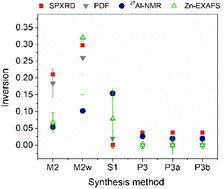Probing the validity of the spinel inversion model: a combined SPXRD, PDF, EXAFS and NMR study of ZnAl2O4†
Abstract
Spinels are of essential interest in the solid-state sciences with numerous important materials adopting this crystal structure. One defining feature of spinel compounds is their ability to accommodate a high degree of tailorable point defects, and this significantly influences their physical properties. Standard defect models of spinels often only consider metal atom inversion between octahedral and tetrahedral sites, thereby neglecting other defects such as interstitial atoms. In addition, most studies rely on a single structural characterization technique, and this may bias the result and give uncertainty about the correct crystal structure. Here we explore the virtues of multi-technique investigations to limit method and model bias. We have used Pair Distribution Function analysis, Rietveld refinement and Maximum Entropy Method analysis of Powder X-ray Diffraction data, Zn edge Extended X-ray Absorption Fine Structure, and solid-state 27Al Nuclear Magnetic Resonance to study the structural defects in ZnAl2O4 spinel samples prepared by either microwave hydrothermal synthesis, supercritical flow synthesis, or spark plasma sintering. In addition, the samples were subjected to thermal post treatments. The study demonstrates that numerous synthesis dependent defects are present and that the different synthesis pathways allow for defect tailoring within the ZnAl2O4 structure. This suggests a pathway forward for optimization of the physical properties of spinel materials.



 Please wait while we load your content...
Please wait while we load your content...